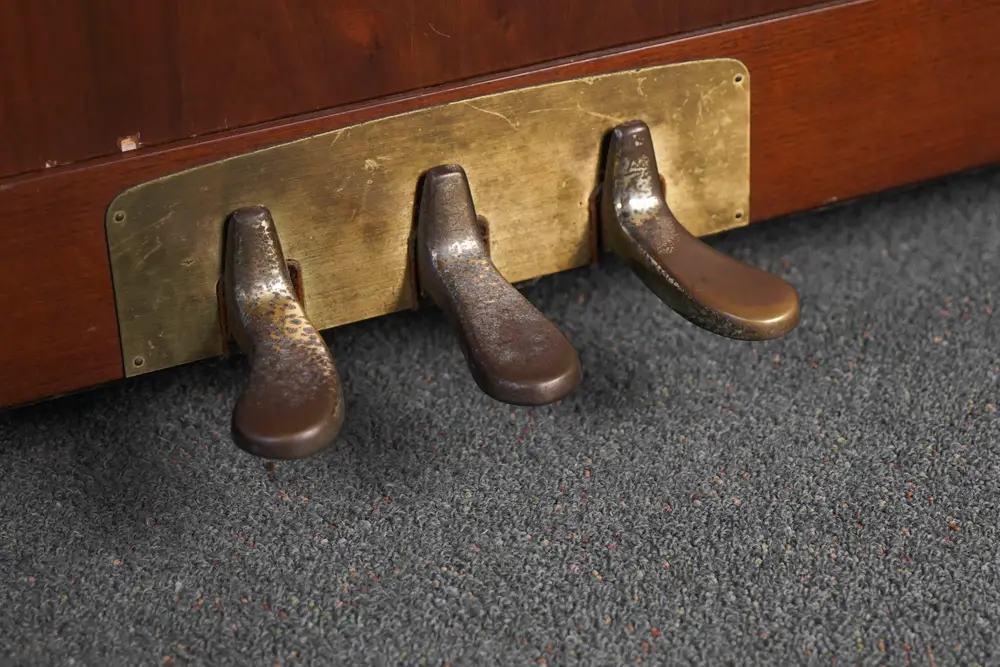
A sustain pedal can be a powerful tool if it’s used correctly.
It allows you to put more feel and emotion into your music.
But, if you don’t use it right, it can do the opposite.
Using too much of it will blend the music together and weaken the harmonies.
Fortunately, some simple tips will help you use the sustain pedal and play piano much more effectively.
This article covers everything you need to know about the sustain pedal and how to use it.
Quick NavigationWhat is a Sustain Pedal?Different Types of Sustain PedalsHow To Use a Sustain PedalPiano Pedaling TechniqueMistakes People Make While Using Sustain PedalsHow to Use the Sustain PedalConclusion
What is a Sustain Pedal?

A sustain pedal, or damper pedal, allows pianists to sustain the sound even when they aren’t holding the notes anymore. As you hold it down, those notes will keep sounding until you let off of it. This device is beneficial in slower music or when transitioning to another chord.
Let’s look at the organ for a moment. This instrument has keys like a piano but no sustain pedal. Organists have to alter their technique to compensate for the lack of pedal. Though this is a classic trait of the organ, it’s much more difficult to make smooth transitions without a sustain pedal.
When you move from chord to chord on a piano, your hands have to jump. Sometimes, it’s a small jump, and sometimes it’s a big one. As your fingers move through the air to the next chord, the sound goes away. If you don’t use a sustain pedal, this silence can affect the flow of the music. When you use it, you don’t need to worry about the transitions to each chord. Your jumping hands are no longer a problem. You can just hold down the pedal and release it as you play the next chord. No silence. That’s why this pedal is a special tool for all pianists.
Different Types of Sustain Pedals

In terms of appearance, there are two different types of sustain pedals. One is a small plastic device that generally looks like a square. This type of pedal is the cheapest kind. The other type resembles a realistic pedal that looks similar to an acoustic piano’s pedal. Though you can use the small plastic type, the realistic models are the most ideal for pianists. The small square models only have one level of sustain, which is 100%. Many realistic models offer several different levels of sustain, just like a real piano. You can get a lot more control by using this type. However, they’re a bit pricer, which is understandable.
On top of that, they usually have a polarity switch. What’s a polarity switch? It’s located on the bottom of the pedal, and it allows you to switch the function. For example, some sustain pedals start out in reverse. They’ll sustain when you’re not holding it down and dampen when you push down. That’s the opposite of what you want. This glitch happens a lot, especially if different companies make the keyboard and pedal. With a polarity switch, it’s an easy fix.
How To Use a Sustain Pedal
Getting good at using this pedal takes some practice. But, in the end, your practice will be worth it.
The best way to learn how to use it is by playing chords. Write down a list of 4 chords you know how to play. Once you’ve done that, play the first chord. You aren’t going to push down the pedal at the same time your fingers play. Play the chord, wait about a second, and then push down the pedal. Take your hands off the keys and listen to the sustained sound. When you take your foot off the pedal, all of the sound will stop.
Now, do the same thing again, except this time, play the next chord, too. Right when your fingers play the next chord, you will lift up the sustain pedal simultaneously. This technique gives you a seamless transition between the chords.
Piano Pedaling Technique

There are techniques you can use to get the most out of the pedal. The first one is flutter pedaling. In this technique, your foot constantly pushes up and down on the pedal. It creates a slight sustain but also clears the notes relatively quickly. The most common places to use it are in faster, non-legato pieces.
Another common technique is direct pedaling. This type of pedaling is arguably the easiest for beginners. You press down the pedal at the same time as you play the notes. You also release it at the same time as you release your hands. This type of pedaling only sustains the individual passage that you play.
These different techniques aren’t interchangeable. They create different sounds and moods, and you can incorporate all of them as you please.
Mistakes People Make While Using Sustain Pedals
There are only two main sustain pedal mistakes: one, using it too much, and two, not using it enough. If you use the sustain pedal too much, the music becomes foggy. The harmonies and chord changes become ambiguous. Lots of times, pianists don’t even realize they’re using it so much.
The pedal is a tool, not a crutch. So, if you find yourself holding it down for a long time, you’re likely using it too much. Laying off of it might make you feel out-in-the-open at first, but you’ll immediately sound 10x better.
Not using this pedal enough can also be a problem. Slow and emotional songs almost always call for some pedal usage. If you find yourself playing a ballad, make sure to use the sustain pedal effectively. The music will flow much better, and you’ll be much happier with the way it sounds.
How to Use the Sustain Pedal
Conclusion
Sustain pedals are a game-changer for pianists. Since most instruments don’t have the luxury of sustaining notes, it’s nice to take advantage of this great musical tool. If you follow some of the tips I included, you can become a better pianist almost immediately. So, get back on the piano bench and start using the sustain pedal!
